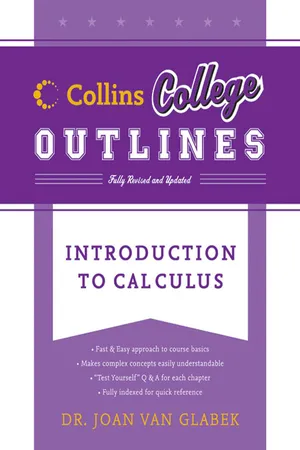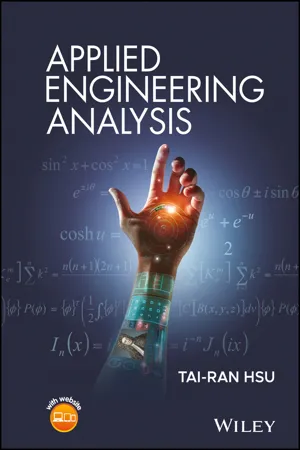Mathematics
Disk Method
The disk method is a technique used in calculus to find the volume of a solid of revolution. It involves slicing a solid shape into thin disks and adding up the volumes of those disks to find the total volume of the shape. This method is commonly used in engineering and physics to calculate the volume of objects with rotational symmetry.
Written by Perlego with AI-assistance
Related key terms
3 Key excerpts on "Disk Method"
- eBook - ePub
- Joan Van Glabek(Author)
- 2011(Publication Date)
- Collins Reference(Publisher)
.Using vertical slices for both integrals, we have: 6.2 VOLUME USING DISKS AND WASHERS In this section, we use the slicing technique to find the volume of various solids. SOLIDS OF REVOLUTIONA solid of revolution is a solid formed by revolving a plane region about a line. Hold up a piece of paper, revolve it around one edge, and the resulting right circular cylinder is a solid of revolution.The Disk MethodOne method for finding the volume of a solid of revolution is called the Disk Method. After a solid has been formed, imagine slicing through it perpendicular to its axis of revolution. If the slice is a solid disk (think of a CD without a hole), the Disk Method is an appropriate choice. The formula is based on the formula for the area of a circle, A = r 2 .Procedure 1: If the function is revolved about y = 0, set up the integralProcedure 2: If the function is revolved about x = 0, solve the given function for x = g (y ) and set up the integralEXAMPLE 6.5Find the volume of the solid formed by revolving the region bounded by f (x ) = 4 – x 2 , x = 0, y = 0 about the x -axis.SOLUTION 6.5Because the equation of the x -axis is y = 0, we use Procedure 1. We find the limits of integration by sketching the plane region f (x ) = 4 – x 2 and determining the x -coordinates where the disks begin and end.Because the region is bounded by x = 0 and intersects the x -axis at x = 2, we set up the following integral:EXAMPLE 6.6Find the volume of the solid formed by revolving the region bounded by f (x ) = 4 – x 2 , x = 0, y = 0 about the y -axis.SOLUTION 6.6Note that this is the same plane region as in Example 6.5, but now it is revolved about x = 0 (the y -axis). The slices are now dy - eBook - ePub
- Tai-Ran Hsu(Author)
- 2018(Publication Date)
- Wiley(Publisher)
Often, engineers need to find the volume of a solid of revolution in order to determine the mass or weight of the solid in many design analyses. The volumes of such solids can be obtained using the special definite integrals described here.Figure 2.28 a indicates a function y(x) that represents the profile of the solid of revolution shown in Figure 2.28 b. The gray element of volume shown in Figure 2.28 a corresponds in position to the cross-section of the solid normal to the axis of revolution that is shown in Figure 2.28 b.The volume of the solid in Figure 2.28 b may be obtained by summing up the volumes of small elements in Figure 2.28 a. These elements may be viewed as thin “disks” with radius y(x) and thickness Δx. This is expressed mathematically aswhere Ai and r are the cross-sectional area and the radius of the “thin” disk element, respectively.The volume of the entire solid is the sum of the volumes of all these “thin” disk elements along the axis of revolution, orin which i designates the disk element number and n is the total number of the disk elements in the subdivided solid.Because the function y(x) that represents the profile of the solid is a continuous function as shown in Figure 2.28 a, we may express the volume of entire solid with the condition that Δx → dx with dx→0. The summation sign in the above expression for the volume V is thus replaced by the integral with the form2.16The volume of a solid of revolution about the y-axis, such as shown in Figure 2.29 , can be determined in a similar manner.Solid volume of revolution about the y-axis.Figure 2.29The area of the shaded element can be expressed as dA = πx2 and the volume of revolution of the shaded element is dv = πx2 dy. The total volume of the solid of revolution about the y - eBook - ePub
Elementary Calculus
An Infinitesimal Approach
- H. Jerome Keisler(Author)
- 2013(Publication Date)
- Dover Publications(Publisher)
Figure 6.2.1 ).Figure 6.2.1We shall work with the region under a curve and the region between two curves. We use one method for rotating about the axis of the independent variable and another for rotating about the axis of the dependent variable.For areas our starting point was the formulafor the area of a rectangle. For volumes of a solid of revolution our starting point is the usual formula for the volume of a right circular cylinder (Figure 6.2.2 ).Figure 6.2.2DEFINITION
The volume of a right circular cylinder with height h and base of radius r isDISC METHOD: For rotations about the axis of the independent variable.Let us first consider the region under a curve. Let R be the region under a curve y = f(x) from x = a to x = b, shown in Figure 6.2.3 (a). x is the independentFigure 6.2.3variable in this case. To keep R in the first quadrant we assume 0 ≤ a < b and 0 ≤ f(x). Rotate R about the x-axis, generating the solid of revolution S shown in Figure 6.2.3 (b).This volume is given by the formula below.VOLUME BY DISC METHOD .To justify this formula we slice the region R into vertical strips of infinitesimal width ∆x. This slices the solid S into discs of infinitesimal thickness ∆x. Each disc is almost a cylinder of height ∆x whose base is a circle of radius f(x) (Figure 6.2.4 ). ThereforeThen by the Infinite Sum Theorem we get the desired formulaFigure 6.2.4EXAMPLE 1 Find the volume of a right circular cone with height h and base of radius r.It is convenient to center the cone on the x-axis with its vertex at the origin as shown in Figure 6.2.5 . This cone is the solid generated by rotating about the x-axis the triangular region R under the line y = (r/h)x, 0 ≤ x ≤ h.Figure 6.2.5Since x
Learn about this page
Index pages curate the most relevant extracts from our library of academic textbooks. They’ve been created using an in-house natural language model (NLM), each adding context and meaning to key research topics.


